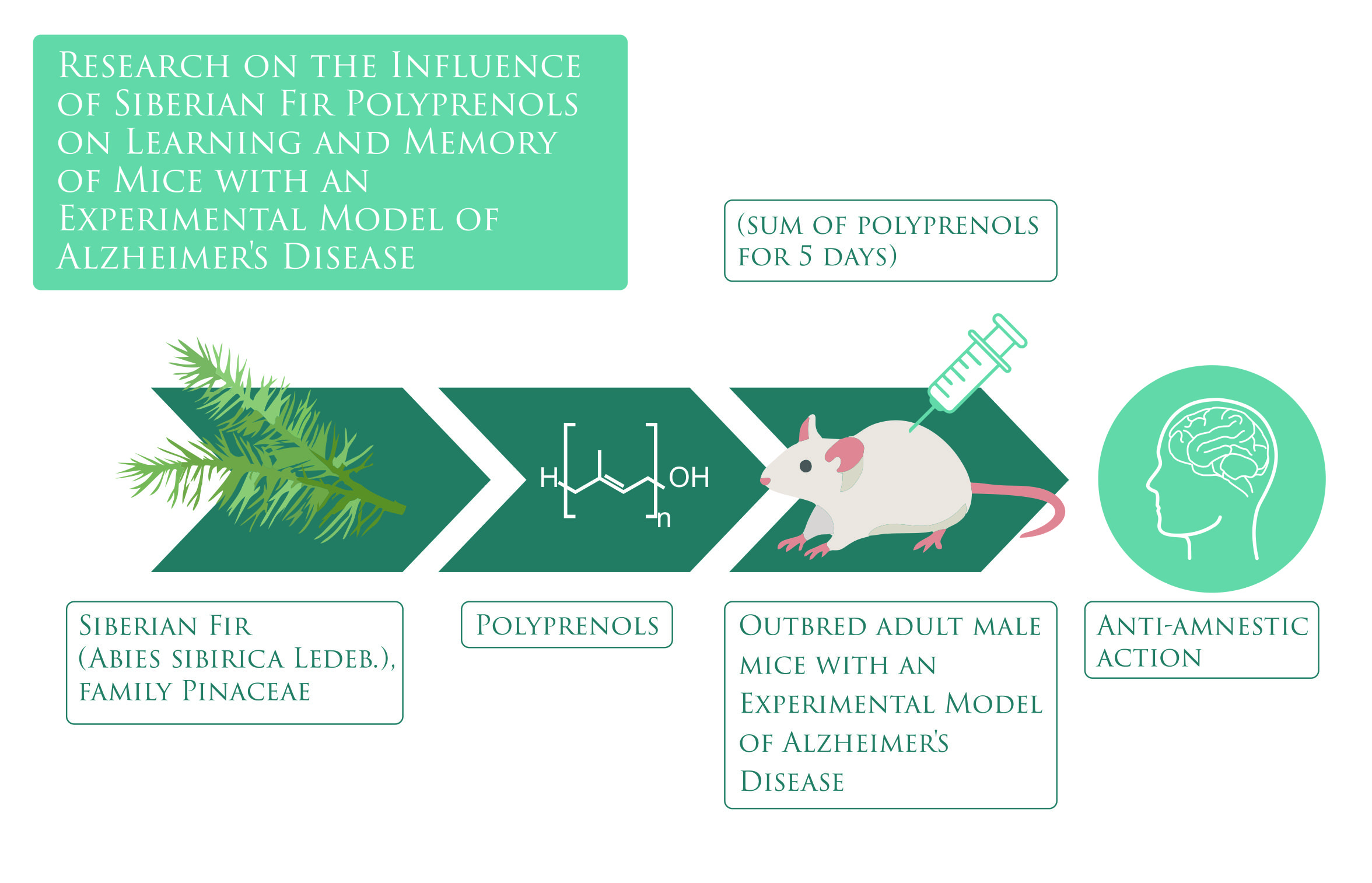Research on the influence of Siberian fir polyprenols on learning and memory of mice with an experimental model of Alzheimer's disease
DOI:
https://doi.org/10.18413/rrpharmacology.10.489Abstract
Introduction: Alzheimer’s disease is increasingly becoming a cause of early disability and death. Attempts to create a pharmacotherapeutic agent that provides an effective result in treating this pathology have so far been unsuccessful. This article presents the results of experimental studies aimed at creating a more effective treatment of Alzheimer’s disease.
Materials and Methods: The object of the study was polyisoprenoids isolated from Siberian fir (Abies sibirica Ledeb.). Experiments were conducted on 108 outbred adult male mice from the CD1 (cluster of differentiation 1) stock, weighing 28-30 g (at 5 weeks old). The effect of the sum of polyisoprenoids on learning and memory was studied in a dose range of 5, 20, 50, 100, 200, and 500 mg/kg. Gliatilin was used as a reference drug at a dose of 90 mg/kg. The experimental model of cognitive dysfunction was created by chronic (for 20 days) intraperitoneal injection of scopolamine at a dose of 2 mg/kg. Cognitive dysfunction was assessed by changes in the indicators of conditioned passive avoidance reflex (CPAR).
Results and Discussion: The results of the experiments showed that chronic administration of scopolamine caused a pronounced decrease in the reproducibility of CPAR. Simultaneously, the studied substance at doses of 20 and 50 mg/kg restored the reproducibility of the reflex to a level close to the values of intact control. Gliatilin showed a similar effect. The authors believe that cholinergic receptors are involved in the development of the anti-amnestic effect.
Conclusion: The presented study demonstrates the discovery of a new agent with anti-amnestic action based on the sum of polyprenols from Siberian Fir (Abies sibirica Ledeb.), family Pinaceae. This agent can be used for the treatment of neurodegenerative pathologies, particularly Alzheimer’s disease.
Graphical Abstract

Keywords:
Siberian fir, polyprenols, dementia, neurodegenerative diseases, cognitive functions disorders therapy, memory enhance, Alzheimer’s diseaseReferences
Beckdash RA (2021) The cholinergic system, the adrenergic system and the neuropathology of alzheimer's disease. International Journal of Molecular Sciences 22(3): 1273. htpps://doi.org/103390/ ijms22031273
Buresh Ya, Bureshova O, Houston JP (1991) Methods and Basic Experiments in the Study of the Brain and Behavior. Higher School Publishing House, Moscow, 398 pp. [in Russian]
Companys-Alemany J, Turcu AL, Vázquez S, Pallàs M, Griñán-Ferré C (2022) Glial cell reactivity and oxidative stress prevention in Alzheimer’s disease mice model by an optimized NMDA receptor antagonist. Scientific Reports 12(1): 17908. https://doi.org/10.1038/s41598-022-22963-x [PubMed] [PMC]
Mironov AN (2012) Guidelines for the Conduct of Preclinical Studies of Medicinal Products. Part one. Griffin and K, Moscow, 291 pp. [in Russian]
Hampel H, Mesulam MM, Cuello AC, Farlow MR, Giacobini E, Grossberg GT, Khachaturian AS, Vergallo A, Cavedo E, Snyder PJ, Khachaturian ZS (2018) The Cholinergic system in the pathophysiology and treatment of Alzheimer’s disease. Brain 141(7): 1917. https://doi.org/10.1093/brain/awy132 [PubMed] [PMC]
Kim HM, Kang SH, Cho S-W, Kang BS (2017) Effects of choline alfoscerate and memantine on memory improvement of scopolamine-induced memory impairment animal model of Alzheimer’s disease. Yakhak Hoeji 61(6): 292. https://doi.org/10.17480/psk.2017.61.6.292
Kenakin T (2008) Overview of receptor interactions of agonists and antagonists. Current Protocols in Pharmacology. 4: Unit 4.1. https://doi.org/10.1002/0471141755.ph0401s42[PubMed]
Huang LK, Kuan YC, Lin HW, Hu CJ (2023) Clinical trials of new drugs for Alzheimer disease: A 2020-2023 update. Journal of Biomedical Science 30(1): 83. https://doi.org/10.1186/s12929-023-00976-6 [PubMed] [PMC]
Liu J, Chang L, Song Y, Li H, Wu Y (2019) The Role of NMDA receptors in Alzheimer’s disease. Frontiers in Neuroscience 13: 43. https://doi.org/10.3389/fnins.2019.00043 [PubMed] [PMC]
Pfundstein G, Nikonenko AG, Sytnyk V (2022) Amyloid precursor protein (APP) and amyloid β (Aβ) interact with cell adhesion molecules: Implication in Alzheimer’s disease and normal physiology. Frontiers in Cell and Developmental Biology 10: 969547. https://doi.org/10:3389/fcell.2022.969547 [PubMed] [PMC]
Shi M, Chu F, Zhu F, Zhu J (2022) Impact of anti-amyloid-β monoclonal antibodies on the pathology and clinical profile of Alzheimer's disease: a focus on aducanumab and lecanemab. Frontiers in Aging Neuroscience. 14: 870517. https://doi.org/10.3389/fnagi.2022.870517[PubMed] [PMC]
Tyuvina NA, Balabanova VV (2015) Treatment of Alzheimer's disease. Neurology, Neuropsychiatry, Psychosomatics 7(3): 80. https://dx.doi.org/10.14412/2074-2711-2015-3-80-85 [in Russian]
Published
How to Cite
Issue
Section
License
Copyright (c) 2024 Николай И. Суслов, Юлия С. Федорова, Максим Л. Коробов

This work is licensed under a Creative Commons Attribution 4.0 International License.
 Русский
Русский
 English
English

